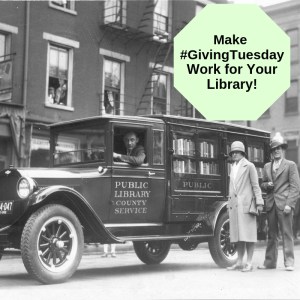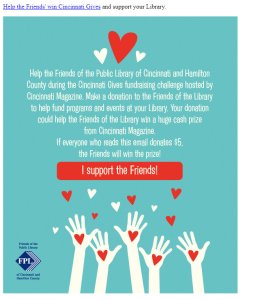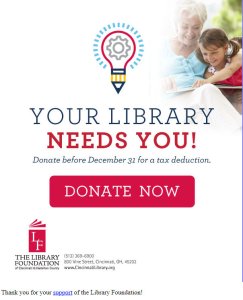
On a mild night in April 2019, I arrived at a steak restaurant in Schaumburg Township, Illinois to have dinner with a group of people I’d never met.
I had been invited to speak at an event put on by the Illinois Library Association. I was set to meet some of the library marketers who conspired to bring me to their event.
That’s the first time I laid eyes on Sue Wilsey. Sue is the gregarious, dynamic Director of Strategic Communications and Marketing for Helen Plum Library.
Sue is a lot of fun. She has a set of eyeglasses to match every single outfit. And she’s a fierce advocate and supporter of libraries.
At that table, I first heard her talk about her work to help bring a new library building to her community. Now, four years later, the new Helen Plum Library is finally open. I asked Sue and her team to share how they managed the final piece of that journey: the communication surrounding the building’s opening.
Sue works with Marketing Content Coordinator Emily Bradshaw, who volunteered at Champaign Public Library for a short time during her undergrad.
“I will never forget during my orientation tour, a proud library staff member showed me their new automated materials-sorting machine,” remembered Emily. “They had placed a Sorting Hat from Harry Potter on top of the platform where it scanned in the books. I knew I had found my people.”
Kristie Leslie is Marketing Manager for Helen Plum. She and her twin sister met their current adult groups of friends at a library storytime as preschoolers.
The final member of the team is Graphic Designer Steph Koblich, who grew up browsing picture books at the library, and admiring their illustrations, which led her to a career in illustration and design.
“My high school was a few blocks from a library, so I would walk there after school almost daily to read or study,” said Steph.
As for Sue, she’s been an avid library user since she was a pre-teen.
“My local branch library was more than a mile away, but my two younger sisters and I happily clomped through the snow or dripped with sweat carrying arms full of Nancy Drew and Bobbsey Twins books,” recalled Sue. “So, it was natural that decades later while needing to research a new career move, I visited my suburban neighborhood library. There are saw a job opportunity posted for a Marketing Supervisor. I knew I had found the final chapter of my life.”
The Helen Plum Library dates to 1928. The original building was the home of Colonel William and Helen Plum. A new library was constructed and opened in 1963, then renovated in 1978.
But in 1999, a space needs study called for an expansion that would more than double the size of the library building to 79,000 square feet. It took another 17 years for the library to secure the funding and property they needed for the construction and operation of a new facility.
Then the project hit a snag. After several years of negotiation with the library’s neighboring Park District, the two parties were unable to come to a suitable agreement regarding air rights and other construction issues. The Library Board decided to relocate to a new site that would best suit the needs of the community. There was an upside to this approach: the new building could be constructed without interruption to day-to-day operations.
“The key to this story is how we were able to convince a Chicago suburban community to vote in favor of a referendum that would raise their taxes,” said Sue. “I personally spoke to folks in the community at nearly 50 different places. We held meet and greets at local watering holes, met with parents and teachers at their schools and organizations, and went to churches, clubs, and service organizations. We recruited believers to help fundraise for lawn signs and ads. Our supporters received a great amount of guidance from John Chrastka and EveryLibrary.”
And that hard work paid off. The new facility, which opened in April, includes a drive-up window, a maker space, and lots of room for patrons to browse and mingle.
“The access to equipment and all of the possibilities for creating that our Studio 411 maker space provides is what I am personally most excited about,” exclaimed Steph. “From color and fabrics to natural light, every spot in the library is aesthetically pleasing and welcoming.
“I’m personally quite excited for our new fireplace as well as the two outdoor spaces, a children’s garden, and outdoor patio,” said Emily. “Everything will be so beautiful, and I’m really looking forward to taking gorgeous Instagram pics!”
The library created a landing page to communicate everything involved with the move.
“The inspiration for the ‘dashboard’ approach came from our COVID-era communications,” explained Kristie. “We wanted one place for patrons to be able to see everything at-a-glance during our closure in 2020, with the bonus of also keeping the content updates focused on one spot rather than the headache of having to hunt throughout the site for making changes.
“We started with everything we thought necessary and considered it a living document. “If we received a question that we consider other patrons likely to have, we would add it to the page.”
And there were lots of other communication channels to consider as the project progressed.
“Our communications plan included myriad facets, from regularly updated videos of the ongoing construction posted on our website and linked in our social media, to print mailers to the community,” said Sue. “We also held a series of virtual ‘Community Conversations’ for the public with our architects and administrators. Recordings of those meetings are available online.”
“Before and during the move, we made information available at services desks as well as in our email newsletter and social media channels detailing which services would and would not be available during the closure,” explained Emily. “We encouraged patrons to sign up for reciprocal borrowing at nearby libraries and promoted our digital materials and resources heavily.”
As you can imagine, there were lots of challenges for the marketing staff at Helen Plum, starting with the uncertainty of the construction schedule. Supply chain issues and other construction glitches caused delays. But the team decided to be open and transparent about the process with the community to help combat concerns and complaints.
“What has gone smoothly is the abundance of community support we have received and the resilience of our staff members,” said Sue. “The flexibility and pivoting that was learned during the pandemic has been valuable in this process.”
As the move-in day approached, the marketing team began prepping for the grand opening celebration.
“We sent a printed invitation to the residents of Lombard and posted Grand Opening information on our website, social media, and email newsletters,” explained Emily. “We also sent out press releases and got coverage from several local newspapers. We partnered with local restaurants to provide small bites throughout the Grand Opening weekend, and several of those restaurants posted about us on social media, as well as some other local businesses whom we didn’t partner with but who were so excited to see us open!”
“One of the most fun collaborations was with two local breweries who created special library-themed brews for the occasion,” continued Emily. “We took some photos and videos with them and made custom coasters which we included in gift bags at the Grand Opening and at their breweries.”
Emily also helped produce a video in which prominent community members pass the library’s copy of Mo Willem’s Waiting is Not Easy from the old library to the new library.
“It made many of our followers emotional,” shared Emily.
The library’s grand opening weekend drew a whopping 5,508 attendees, far more than the marketing team expected! Guests received a swag bag, participated in a scavenger hunt, and munched on local snacks.
“It was amazing to see the place come alive with patrons who were so thrilled to finally step inside their new library,” remembered Emily. “We were overwhelmed by the amount of joy and support we received that weekend. I think everyone was a bit shocked – in the best way!”
The library recently sent an extra-large version of their summer newsletter featuring building photos to all residents, to make sure everyone who couldn’t attend the grand opening understands the value this new building brings to the community.
Now, as the library staff settles into the building, the marketing staff of Helen Plum is planning for a new, busier normal. There are still areas of the library undergoing construction, so they’ll continue to provide updates on building developments as the space comes to life.
“For example, since opening, we’ve added a fire table to our outdoor patio space, bike racks, a coffee machine, and some beautiful wallpaper murals,” explained Emily. “Our maker space, Studio 411, is still adding new equipment, and we hope to launch programs in that space in the fall. We are also kicking off our 2023 Summer Reading Program on June 1, and we’re looking forward to using that as an opportunity to welcome patrons who haven’t gotten a chance to stop by yet.”
“As we all get the hang of things in the new space, we plan to dip our toes into exhibits and library-wide events that can bring the whole community in and give us village-wide exposure,” planned Kristie. “I’m so excited to have seen such a huge uptick in new cardholders—from April 22 to May 22, we registered 1,133 new cardholders, an over 600 percent increase from the previous year.”
More Advice
Subscribe to this blog and you’ll receive an email whenever I post. To do that, enter your email address and click on the “Follow” button in the lower left-hand corner of the page. You can also follow me on the following social media platforms:











